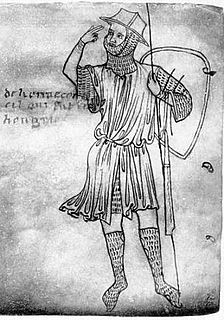
Villard de Honnecourt was a 13th-century artist from Picardy in northern France. He is known to history only through a surviving portfolio or "sketchbook" containing about 250 drawings and designs of a wide variety of subjects.

Sacred geometry ascribes symbolic and sacred meanings to certain geometric shapes and certain geometric proportions. It is associated with the belief that a god is the geometer of the world. The geometry used in the design and construction of religious structures such as churches, temples, mosques, religious monuments, altars, and tabernacles has sometimes been considered sacred. The concept applies also to sacred spaces such as temenoi, sacred groves, village greens, and holy wells, and the creation of religious art.

A medieval university is a corporation organized during the Middle Ages for the purposes of higher education. The first Western European institutions generally considered universities were established in the Kingdom of Italy, the Kingdom of England, the Kingdom of France, the Kingdom of Spain, and the Kingdom of Portugal between the 11th and 15th centuries for the study of the Arts and the higher disciplines of Theology, Law, and Medicine. During the 14th century there was an increase in growth of universities and colleges around Europe. These universities evolved from much older Christian cathedral schools and monastic schools, and it is difficult to define the exact date when they became true universities, though the lists of studia generalia for higher education in Europe held by the Vatican are a useful guide.

Mason Science College was a university college in Birmingham, England, and a predecessor college of Birmingham University. Founded in 1875 by industrialist and philanthropist Sir Josiah Mason, the college was incorporated into the University of Birmingham in 1900. Two students of the college, Neville Chamberlain and Stanley Baldwin, later went on to become Prime Ministers of the UK.

The canons of page construction are historical reconstructions, based on careful measurement of extant books and what is known of the mathematics and engineering methods of the time, of manuscript-framework methods that may have been used in Medieval- or Renaissance-era book design to divide a page into pleasing proportions. Since their popularization in the 20th century, these canons have influenced modern-day book design in the ways that page proportions, margins and type areas of books are constructed.

Mariano di Jacopo, called Taccola, was an Italian polymath, administrator, artist and engineer of the early Renaissance. Taccola is known for his technological treatises De ingeneis and De machinis, which feature annotated drawings of a wide array of innovative machines and devices. Taccola's work was widely studied and copied by later Renaissance engineers and artists, among them Francesco di Giorgio, and Leonardo da Vinci.

Girih is a decorative Islamic geometric artform used in architecture and handicraft objects, consisting of angled lines that form an interlaced strapwork pattern.

Henry Pelham Holmes Bromwell was an American lawyer, politician from Illinois, and prominent Freemason. He was a lawyer and judge who served as a U.S. Representative from Illinois from 1865–1869 and continued to practice law when he moved to Colorado in 1870 where he was appointed to compile the state's statutes. Bromwell was initiated into freemasonry in 1854, and he became the Grand Master of Illinois in 1864. When he moved to Colorado he became that state's first Honorary Grand Master. He developed the Free, and Accepted Architects, a new rite for Freemasonry which sought to teach its initiates the lost work of the craft embodied in Bromwell's Geometrical system. After his death, the Grand Lodge of Colorado published his work on the esoteric nature of Sacred geometry in the book Restorations of Masonic Geometry and Symbolry.

Lucien Lagrange is an architect and a former partner at Skidmore, Owings & Merrill, who founded his own firm, named Lucien Lagrange Architects in 1985. The studio is a representative of New Urbanism and New Classical Architecture.

Geometry is a branch of mathematics concerned with questions of shape, size, relative position of figures, and the properties of space. A mathematician who works in the field of geometry is called a geometer.

Islamic decoration, which tends to avoid using figurative images, makes frequent use of geometric patterns which have developed over the centuries.

Robert Edward Williams is an American designer, mathematician, and architect. He is noted for books on the geometry of natural structure, the discovery of a new space-filling polyhedron, the development of theoretical principles of Catenatic Geometry, and the invention of the Ars-Vivant Wild-life Protector System for repopulating the Western Mojave Desert in California, USA with desert tortoises.

The Cathedral of Notre Dame of Lausanne is a church located in the city of Lausanne, in the canton of Vaud in Switzerland. It belongs to the Evangelical Reformed Church of the Canton of Vaud.

Carl Georg Brunius was a classical scholar, art historian, archaeologist and architect working in the university town of Lund in southern Sweden.

Irving Lavin was an art historian of Late Antique, Medieval, Renaissance, Baroque, and Modern painting, sculpture, and architecture. His wide-ranging contributions centered primarily on the correlation between form and meaning in the visual arts.
John Roger Haughton James OAM is a British-born Australian architect and historian.
Sariel Har-Peled is an Israeli–American computer scientist known for his research in computational geometry. He is a Donald Biggar Willett Professor in Engineering at the University of Illinois at Urbana–Champaign.






















